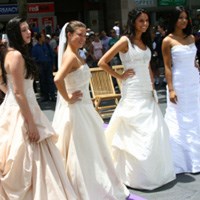Marry me Microsoft campaign a hit Down Under

In the PC-vs-Mac discussion, there was also a growing perception that the PC is the computer used at work, while a Mac was used in the home. On the spectrum of work vs play, Microsoft was very much positioned on the former, and this needed to be changed. In Microsoft's favour, the rise of cloud computing offered a common thread to deliver a clear, cohesive - and importantly a non-work related - consumer benefit story that incorporated the entire Microsoft eco-system.
Unlike Apple, Microsoft offered an intangible rather than a physical product, meaning that a TVC showcasing hardware wasn't an option. The story lies not in the product, but in Microsoft's role in the bigger consumer benefit story.
It was decided that the consumer-benefit story was too big to live within the constraints of a 30-second TVC. The only media bought for the campaign was a few radio spots and some Facebook placements.
Identifying a life-changing event to which all can relate
Instead, Microsoft identified a life-changing event to which everyone could relate, and brought that event to life in real-time, in real-life and in public and on Facebook for everyone to see. Microsoft decided to plan a wedding.

Windows 7, Windows Live and Office 2010, products that in Australia were perceived as being inextricably linked with work rather than play drove the idea. Marry Me Microsoft was a weeklong installation in Sydney's Circular Quay, opposite the famous Opera House. A groom was locked in what was dubbed the "Bachelor Bubble" where he was physically fenced off from the rest of the world with access only to Microsoft products and an internet connection. He then had five days to plan his wedding from scratch, with help from the general public.
Throughout the campaign, Facebook became the hub for all of the Marry Me Microsoft activity - so rather than building microsites and partnership pages the campaign lived organically in the social environment. The first chapter was about finding the right couple using Facebook, radio mentions and earned TV coverage. Engaged couples were asked to upload videos of themselves, with the lucky couple (as voted for by the public) receiving A$25 000* to plan their wedding.
In December 2010, bachelor Mike moved into his Bachelor Bubble to get started. By using cloud computing across Microsoft products Office 2010, SkyDrive, Internet Explorer 9, Windows 7 and Windows Live, Mike had everything he needed to get started. Over the next five days Mike did everything any normal wedding planner would to cover. This included things like choosing the flowers, invitations, colour scheme, food and even the wedding dress without the help of his bride to be. Instead, he had the help of the Australian public and local experts.
Marry me Microsoft - the competition wrap-up
Results
With almost zero paid media support, the campaign reached a total unique audience of 2.6 million.
In product perception scores:
Windows 7 saw an increase in 'innovative' from 59% to 73%, and an increase in 'good quality' from 58% to 70% and an increase in interest in the product from 70% to 86%
Windows Live saw an increase in 'understand key features' from 39% to 69%, an increase in 'innovative' from 49% to 65%, an increase in 'good quality' from 45% to 66% and an increase in interest in the product from 61% to 83%
Sky Drive saw an 'understand key features' from 7% to 19%, an increase in 'innovative' from 60% to 71% and an increase in interest in the product from 55% to 77%
Office 2010 experienced an increase in understanding of 'access anywhere' from 46% to 61%, an increase in 'understanding key features' from 19% to 55% and an increase in interest in the product from 69% to 82%
*Exchange rate at time of posting: A$1=R8.29
Source: Cream: Inspiring Innovation
Cream is a curated, global case study gallery of excellence, providing the marketing community with the latest trends and inspiration to help grow their business.
Go to: http://www.creamglobal.com


